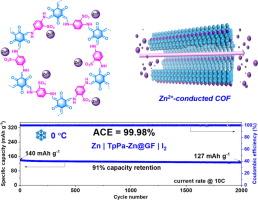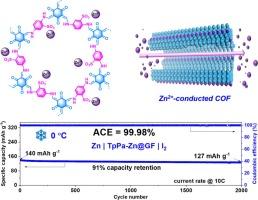Wide-temperature zinc-iodine batteries enabling by a Zn-ion conducting covalent organic framework buffer layer
IF 13.3
1区 工程技术
Q1 ENGINEERING, CHEMICAL
引用次数: 0
Abstract
Aqueous zinc-iodine batteries (ZIBs) are attractive energy storage devices owing to their safety and low cost, but polyiodide shuttling and poor wide-temperature operation limit their scalability. Herein, a sulfonated zinc-grafted covalent organic framework (COF) (denoted TpPa-Zn) was designed and served as the buffer layer on the surface of glass fiber (GF) to enhance ZIBs’ performance. The TpPa-Zn structure exhibits single zinc-ion conductivity, with its nanopores and sulfonic acid groups effectively suppressing polyiodide shuttling. In-situ Raman and X-ray photoelectron spectroscopy tests revealed that the TpPa-Zn modified separator promotes polyiodide conversion, reducing self-discharge and enhancing cycle stability. The upgraded ZIBs were demonstrated with ultra-stable operation over a wide temperature ranging from 0 to 65 ℃, retaining 90.5 % and 90.7 % capacity retention rate at 65 ℃ (500 cycles) and 0 ℃ (2000 cycles), respectively. Moreover, high-iodine-loading tests demonstrated practical applicability, with a retention rate of 87 % at 3 mg cm−2 and 93 % at 5 mg cm−2. This study elucidates that the TpPa-Zn buffer layer significantly improves the temperature adaptability of ZIBs, potentially inspiring the rational design of COF-based wide-temperature batteries.


通过锌离子导电共价有机框架缓冲层实现宽温锌碘电池
锌碘水溶液电池(ZIBs)因其安全性和低成本而成为极具吸引力的储能设备,但多碘化物穿梭和宽温操作性差限制了其可扩展性。本文设计了一种磺化锌接枝共价有机框架(COF)(记为 TpPa-Zn),并将其作为玻璃纤维(GF)表面的缓冲层,以提高 ZIB 的性能。TpPa-Zn 结构具有单一锌离子导电性,其纳米孔和磺酸基团有效抑制了多碘化物的穿梭。原位拉曼光谱和 X 射线光电子能谱测试表明,TpPa-Zn 改性隔膜可促进聚碘化物的转化,减少自放电并提高循环稳定性。升级后的 ZIB 在 0 至 65 ℃ 的宽温度范围内均能超稳定运行,在 65 ℃(500 次循环)和 0 ℃(2000 次循环)下的容量保持率分别为 90.5% 和 90.7%。此外,高碘负荷测试也证明了其实用性,在 3 毫克/厘米-2 和 5 毫克/厘米-2 的条件下,容量保持率分别为 87% 和 93%。这项研究阐明,TpPa-Zn 缓冲层显著提高了 ZIB 的温度适应性,有可能激发基于 COF 的宽温电池的合理设计。
本文章由计算机程序翻译,如有差异,请以英文原文为准。
求助全文
约1分钟内获得全文
求助全文
来源期刊

Chemical Engineering Journal
工程技术-工程:化工
CiteScore
21.70
自引率
9.30%
发文量
6781
审稿时长
2.4 months
期刊介绍:
The Chemical Engineering Journal is an international research journal that invites contributions of original and novel fundamental research. It aims to provide an international platform for presenting original fundamental research, interpretative reviews, and discussions on new developments in chemical engineering. The journal welcomes papers that describe novel theory and its practical application, as well as those that demonstrate the transfer of techniques from other disciplines. It also welcomes reports on carefully conducted experimental work that is soundly interpreted. The main focus of the journal is on original and rigorous research results that have broad significance. The Catalysis section within the Chemical Engineering Journal focuses specifically on Experimental and Theoretical studies in the fields of heterogeneous catalysis, molecular catalysis, and biocatalysis. These studies have industrial impact on various sectors such as chemicals, energy, materials, foods, healthcare, and environmental protection.
 求助内容:
求助内容: 应助结果提醒方式:
应助结果提醒方式:


